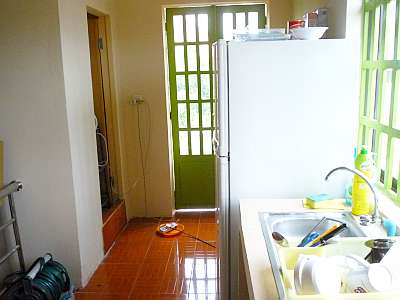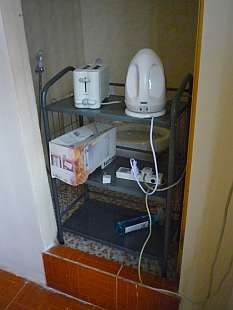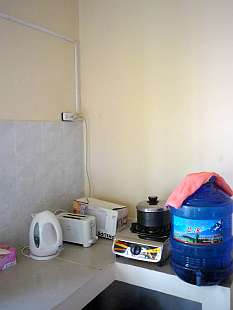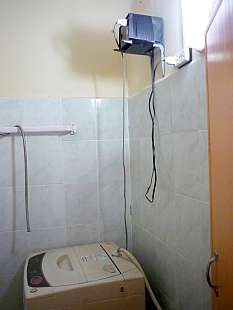28 May 2010
|
||
 |
Modern kitchens have multiple AC outlets spread throughout the room. The kitchen in our new house had only one electrical outlet--located four feet off the ground, in between two doorways, and able to accept only two-round-pin plugs. As a temporary workaround, we ran an extension cord across the doorway so that we could plug in our refrigerator. The plastic plate under the power strip part of the extension is to keep it out of the water which blows around and under the back doors when it rains because there are no door jambs or thresholds. | |
 |
We also have a pot to heat hot water and a toaster so we put them on a little stand that would fit inside the doorway of the bathroom in the kitchen until we were able to arrange for additional wiring in the house. Luckily the landlord readily agreed to the modifications. The landlord family living on the first floor of this same building would have none of these appliances and so it would not occur to them to plan ahead for wiring when they built the house. Today in Cambodia probably less than 5% of family houses have refrigerators because of the high cost of electricity and a lifestyle which centers on going to the market each day. Even fewer families would have a water heater or toaster or other kitchen appliance. | |
 |
The landlord brought in his own electrician, an older man who did really good work, and soon we had three additional outlets on a wall where there were none before. Now we can keep the toaster and water heater there. It's not quite ideal, though. He placed the outlet so high above the counter, to keep from drilling the tile, that the water heater cord won't reach it without an extension. Note our one-burner stove that connected to an LPG tank on the floor and our drinking water bottle. | |
 |
This transformer, to step the 220v down to 110v required by the washing machine, was added upstairs in the bathroom converted to a laundry room. | |